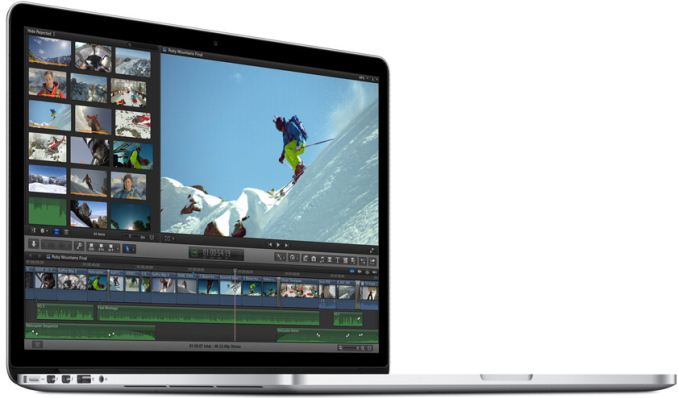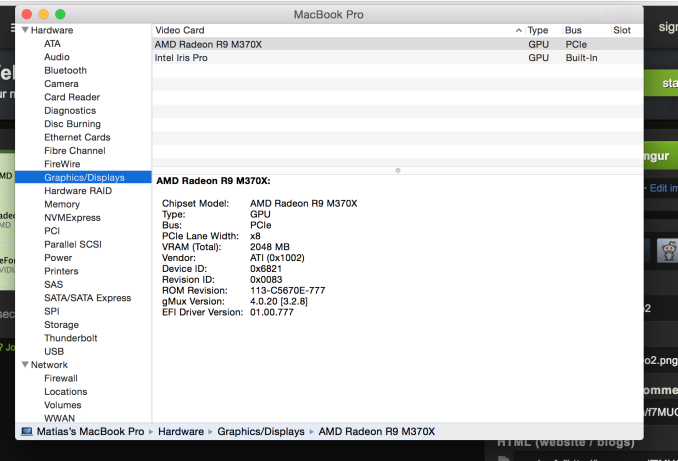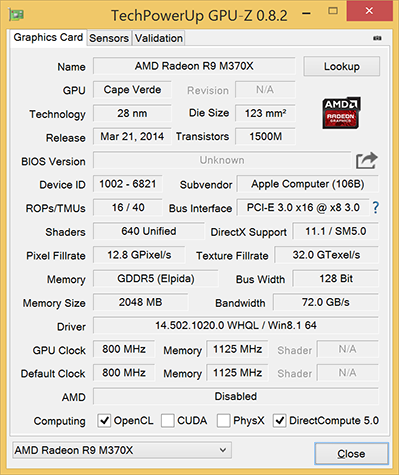2015 15-inch Retina MacBook Pro’s dGPU (R9 M370X) Is Cape Verde
by Ryan Smith on May 23, 2015 12:16 AM EST- Posted in
- GPUs
- Mac
- AMD
- Apple
- MacBook Pro
- Radeon
- Radeon 300

Earlier this week Apple announced their 2015 15” Retina MacBook Pro. Though Apple didn’t make any CPU changes, they did make some GPU changes on the high-end model, swapping out NVIDIA’s GeForce GT 750M for AMD’s Radeon R9 M370X. Since the M370X was not a published part number in AMD’s recently-announced 2015 Radeon M300 series refresh lineup, there have been some questions over just what M370X really is.
At the time of the rMBP’s launch, we suspected that it was an AMD Cape Verde GPU, based on the fact that this GPU is also in the M375, which is the next part above M370X. With the new laptop shipping immediately, M370X models have already begun arriving in buyers’ hands, finally giving us a chance to confirm the GPU inside.

Image courtesy Reddit user ootan
Thanks to Reddit user ootan, who posted a screenshot of the rMBP’s System Profiler, we can now confirm that the GPU in the rMBP is in fact AMD’s Cape Verde GPU. AMD has previously used the 6821 device ID on other mobile Cape Verde parts, so 6821 is already a known quantity.
| AMD M300 Series GPU Specification Comparison | |||||
| R9 M375 | R9 M370X (rMBP) | R7 M360 | |||
| Was | Variant of R9 M270/M260 | Variant of R9 M270X | Variant of R7 M270/M260 | ||
| Stream Processors | 640 | 640 | 384 | ||
| Texture Units | 40 | 40 | 24 | ||
| ROPs | 16 | 16 | 4? | ||
| Boost Clock | <=1015MHz | 800MHz | <=1015MHz | ||
| Memory Clock | 2.2GHz DDR3 | 4.5GHz GDDR5 | 2GHz DDR3 | ||
| Memory Bus Width | 128-bit | 128-bit | 64-bit | ||
| VRAM | <=4GB | 2GB | <=4GB | ||
| GPU | Cape Verde | Cape Verde | Oland/Topaz | ||
| Manufacturing Process | TSMC 28nm | TSMC 28nm | TSMC 28nm | ||
| Architecture | GCN 1.0 | GCN 1.0 | GCN 1.0 | ||
As for Cape Verde itself, as our regular readers may already know, it’s one of AMD’s first-generation GCN 1.0 GPUs, launched back in 2012. Compared to the GK107 GPU found in the GT 750M, it is a larger, more powerful (and at least in the desktop, more power-hungry) GPU, designed for more powerful devices than GK107 was. As for why Apple opted to switch now and to this GPU, we’ll leave that to Apple, AMD, and NVIDIA, though it’s by no means surprising that after having run GK107 for a couple of years, they would want to upgrade to a more powerful GPU.
Meanwhile, though we don’t have M370X on-hand at the moment, at least in the desktop, where GPU performance is unrestricted by thermals, Cape Verde fares very well. The rMBP on the other hand does have thermal constraints to deal with, so performance won’t be the same, but I expect it to fare reasonably well as well. Though at the same time I’m also curious if the use of a higher performance part has impacted the rMBP’s battery life when the dGPU is active; AMD and NVIDIA both do heavy binning, so a simple extrapolation won’t work here.
Update: And no sooner do I post this then someone sends me a screenshot of GPU-Z from a 15" rMBP running Boot Camp.
GPU-Z, for those unfamiliar with it, uses register poking to identify GPUs, so if the device ID wasn't enough, this settles it. This also confirms the clockspeeds - 800MHz core, 4.5GHz VRAM - and that the M370X is using GDDR5, unlike it's M375 counterpart. Thank you DMDrew812.
Source: Reddit User ootan (via SH SOTN)











107 Comments
View All Comments
halo37253 - Sunday, May 24, 2015 - link
OpenCL performance....Macs are not gaming machines, and Nvidia's lower end chips underperform compute wise.
dragonsqrrl - Monday, May 25, 2015 - link
Maxwell is very competitive in OpenCL performance. And any advantage Cape Verde might have in a particular workload certainly wouldn't be enough to offset the difference in performance per W.Stuka87 - Tuesday, May 26, 2015 - link
nVidia only supports OpenCL 1.2 (and this is very recent). AMD supported 1.2 many many years ago, and has full 2.0 compliance currently, as does Intel. Apple wants OpenCL 2.0 support as OS X uses it internally. nVidia has purposely held back its OpenCL development as they rather push their own proprietary CUDA.dragonsqrrl - Tuesday, May 26, 2015 - link
That would be a nice theory, except that AMD only supports OpenCL 2.0 on GCN 1.1 and newer GPU's. GCN 1.0 is limited to OpenCL 1.2.Dug - Tuesday, May 26, 2015 - link
Wouldn't a variant of the tech allow OpenCL 2.0?tipoo - Thursday, October 6, 2016 - link
https://cdn.arstechnica.net/wp-content/uploads/201...?
Competitive? That's an Iris Pro beating them.
Taneli - Monday, May 25, 2015 - link
Your source? At least according to Anandtech's review Maxwell OpenCL compute performance is really good. The consumer parts have only a little DP FP hardware, but that is NOT needed in consumer applications. Not even in Apple's own softwareMorawka - Saturday, May 23, 2015 - link
wow cant believe apple used this gpu over nvidia's offerings. they must really be mad at nvidia to go with a 4 year old architecture.they could have got the same performance with 30% less heat and power with nvidia.
Probably just a stop gap till 14nm ff, but i won't ever pay $2k +++ for a laptop with an amd gpu
Morawka - Saturday, May 23, 2015 - link
on the plus side, all these gpu switch-a-roo's are gonna make a hackintosh much easier to build with a wider variety of parts.ImSpartacus - Saturday, May 23, 2015 - link
That's a nice little fringe benefit.